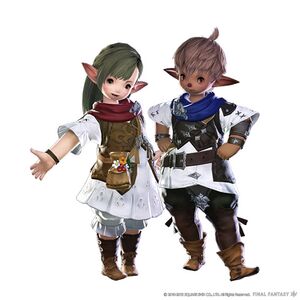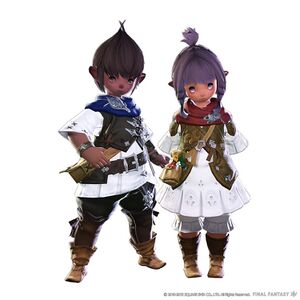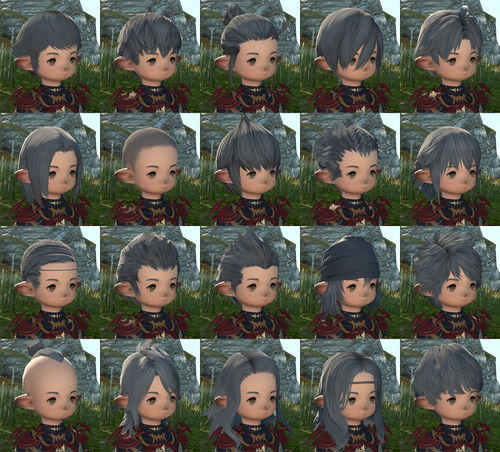Difference between revisions of "Lalafell"
| Line 13: | Line 13: | ||
After the [[War of the Magi]] ended with the [[Sixth Umbral Calamity]], the surviving Lalafell of Nym returned to their homelands in the southern seas, while the Lalafell of Mhach returned home to find a salt-drenched moor where once was their fertile valley.<ref name="The Lalafell"/> | After the [[War of the Magi]] ended with the [[Sixth Umbral Calamity]], the surviving Lalafell of Nym returned to their homelands in the southern seas, while the Lalafell of Mhach returned home to find a salt-drenched moor where once was their fertile valley.<ref name="The Lalafell"/> | ||
The Lalafellin sons and daughters of Mhach concealed themselves in the remote outlands during the early [[Sixth Astral Era]], then ventured into [[Thanalan]], eventually undergoing minor physiological changes and becoming the [[Dunesfolk]]. They founded the city-state of [[Belah'dia]], which ultimately split into [[Sil'dih]] and [[Ul'dah]], the latter of which prospers still today. [[Plainsfolk]] arrived in Eorzea as maritime traders from the south sea islands who came to [[Limsa Lominsa]] for profit. They settled on [[Vylbrand]], and predominantly live as farmers to this day.< | The Lalafellin sons and daughters of Mhach concealed themselves in the remote outlands during the early [[Sixth Astral Era]], then ventured into [[Thanalan]], eventually undergoing minor physiological changes and becoming the [[Dunesfolk]]. They founded the city-state of [[Belah'dia]], which ultimately split into [[Sil'dih]] and [[Ul'dah]], the latter of which prospers still today. [[Plainsfolk]] arrived in Eorzea as maritime traders from the south sea islands who came to [[Limsa Lominsa]] for profit. They settled on [[Vylbrand]], and predominantly live as farmers to this day.<ref name="The Lalafell"/> | ||
Both the first and second [[Ul Dynasty]] are of Lalafellin lineage, and the majority of Ul'dahns are Dunesfolk.<ref>''Encyclopaedia Eorzea'' pg. 128-129</ref> While the Plainsfolk are comparatively small in number, they have made notable contributions to Limsa Lominsa, bringing the art of arcanima to the city-state.<ref name="Geography"/> The Lalafellin arcanist [[Ikuku Iku]] convinced [[Admiral Mealvaan]] to open [[Mealvaan's Gate]] in 1062 of the Sixth Astral Era, an organization of customs officials that also serves as the Arcanists' Guild in the modern day.<ref>''Encyclopaedia Eorzea'' pg. 049</ref> | Both the first and second [[Ul Dynasty]] are of Lalafellin lineage, and the majority of Ul'dahns are Dunesfolk.<ref>''Encyclopaedia Eorzea'' pg. 128-129</ref> While the Plainsfolk are comparatively small in number, they have made notable contributions to Limsa Lominsa, bringing the art of arcanima to the city-state.<ref name="Geography"/> The Lalafellin arcanist [[Ikuku Iku]] convinced [[Admiral Mealvaan]] to open [[Mealvaan's Gate]] in 1062 of the Sixth Astral Era, an organization of customs officials that also serves as the Arcanists' Guild in the modern day.<ref>''Encyclopaedia Eorzea'' pg. 049</ref> | ||
Revision as of 02:11, 19 July 2018
Short, stocky, and rotund, the Lalafell are the smallest of Eorzea's races. They maintain a youthful, childlike appearance, even in old age, making their true age difficult for other races to ascertain.[1] Originally an agricultural people of the southern isles, they came to Eorzea following mercantile trade. They're welcoming of outsiders, and share prosperous relations with the other races.[2]
History
The Lalafell descend from an agrarian people native to the fertile islands of the south seas. Gradually, they migrated to Eorzea over the years in pursuit of trade.[1] They traveled across the boundless waters in catamaran-like ships unique to their civilization.[3]
Lalafellin history contains numerous examples of their aptitude for magic. As the art was created in their homelands, the Lalafell were likely key to the development of arcanima, a magic which uses arcane geometries to weave aether into specific magical effect. [4]
In the Fifth Astral Era, the Lalafell were instrumental in the foundation of the city-states of Nym on Vylbrand and Mhach in the lowlands of Yafaem.[1] The scholars of the Royal Nymian Marines were notable for their use of brilliant strategic maneuvering to heal and support their marauder comrades.[5] It was also a Lalafellin sorceress of Mhach named Shatotto who invented the art of black magic.
After the War of the Magi ended with the Sixth Umbral Calamity, the surviving Lalafell of Nym returned to their homelands in the southern seas, while the Lalafell of Mhach returned home to find a salt-drenched moor where once was their fertile valley.[1]
The Lalafellin sons and daughters of Mhach concealed themselves in the remote outlands during the early Sixth Astral Era, then ventured into Thanalan, eventually undergoing minor physiological changes and becoming the Dunesfolk. They founded the city-state of Belah'dia, which ultimately split into Sil'dih and Ul'dah, the latter of which prospers still today. Plainsfolk arrived in Eorzea as maritime traders from the south sea islands who came to Limsa Lominsa for profit. They settled on Vylbrand, and predominantly live as farmers to this day.[1]
Both the first and second Ul Dynasty are of Lalafellin lineage, and the majority of Ul'dahns are Dunesfolk.[6] While the Plainsfolk are comparatively small in number, they have made notable contributions to Limsa Lominsa, bringing the art of arcanima to the city-state.[3] The Lalafellin arcanist Ikuku Iku convinced Admiral Mealvaan to open Mealvaan's Gate in 1062 of the Sixth Astral Era, an organization of customs officials that also serves as the Arcanists' Guild in the modern day.[7]
In modern times, Lalafell rank among the wealthiest individuals in Eorzea, such as Lolorito Nanarito and Teledji Adeledji of the Syndicate. Their enterprising nature has led some—such as Highwind Skyways founder Tatanora—to introduce and develop technologies to heretofore unseen heights with such innovations as chocobo carriages lifted by ceruleum vapor-filled balloons, or popularizing commercial airship flight.[8]
Clans
- Main article: Plainsfolk
- Main article: Dunesfolk
Lalafell are primarily composed of two clans: the grassland-dwelling Plainsfolk and desert-dwelling Dunesfolk, with both tracing their roots to the south sea isles. Though slight differences in physical appearance have emerged over the many generations spent living apart—such as the thin membranes over the eyes of the Dunesfolk—the two clans have no resentment toward one another. In fact, inter-clan marriages are commonplace, with many Lalafell such as Teledji Adeledji possessing both Plainsfolk and Dunesfolk blood. Differences do appear in their names and customs, however.[1]
Culture
Though they place great importance on familial bonds, the Lalafell are not exclusionary. They maintain cordial relations with the other races, and have achieved much success as traders and merchants as a result. Their business-minded nature can lead them to be perceived as greedy and calculating, but few can truly dislike the Lalafell due to their inherently bright and jovial nature. Examples of Lalafell being persecuted by other races are extremely rare.[1]
The scarf is a common fixture of traditional Lalafellin garb, serving the practical function of allowing them to stand out above their modest stature by waving it as a signal flag on the high seas or vast deserts. They favor loose-fitting garments that conceal their naturally rotund builds.[1]
Lalafellin herbalism has been a large influence in the study of alchemy in Ul'dah.
Language
- Main article: Languages
As a race of traders, the Lalafell quickly adopted the common tongue of the Hyur. The old Lalafellin tongue is still spoken today in the islands of the southern seas. Their language is ruled by rhyme, rhythm, and repetition, with additional alliteration liberally littering their lexicon. The old Lalafellin tongue is notably different from those of other races, containing only five distinct vowels: a, e, i, o, and u.[1] This appears to be something the language shares with ancient Hingan and Doman.
The names of Lalafell are made up of a given name and "courtesy name" bestowed upon reaching adulthood. The latter is not a family name, but unique to the individual. Their names originate in songs and poems in the old tongue.[1]
Hairstyles
Male
Female
Notes & Trivia
- Lalafell can be both singular and plural, though the word "Lalafells" is also commonly used. The adjectival form of Lalafell is "Lalafellin."
- The Lalafell are based on the Tarutaru of Final Fantasy XI, with Tataru's name referencing them. They loosely resemble hobbits and halflings common to fantasy settings.
References
- ↑ 1.0 1.1 1.2 1.3 1.4 1.5 1.6 1.7 1.8 1.9 Encyclopaedia Eorzea pg. 084-085
- ↑ FINAL FANTASY XIV | RACES
- ↑ 3.0 3.1 Encyclopaedia Eorzea pg. 013
- ↑ Encyclopaedia Eorzea pg. 104
- ↑ Encyclopaedia Eorzea pg. 033
- ↑ Encyclopaedia Eorzea pg. 128-129
- ↑ Encyclopaedia Eorzea pg. 049
- ↑ Encyclopaedia Eorzea pg. 051-052



